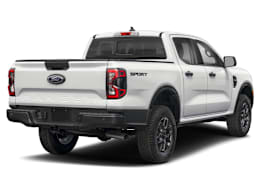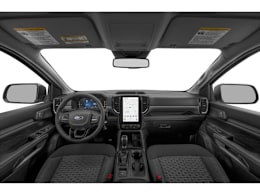The redesigned-for-2024 Ford Ranger is slightly larger than before, including a wider bed, and it has a more modern-looking interior with a tall, vertically oriented infotainment screen. It also benefits from the availability of more active safety and driver assistance features—including reverse automatic emergency braking and adaptive cruise control—along with a newly available turbocharged V6 and a mighty Raptor off-road version.
Yet, at its core the Ranger remains a truly “trucky” vehicle. We had hoped to see a noticeable gain in either ride comfort or handling prowess (or both!), but that hasn’t materialized. Instead, the Ranger keeps on truckin’ with a stiff, bouncy, and unrefined ride, clumsy handling, and long stopping distances. Further, blind spot warning and rear cross traffic warning are optional, rather than standard.
The result is that, beyond its fairly refined turbocharged four-cylinder engine, comfortable front seats, and roomy driving position, little else about the new Ranger separates it from its midsized pickup-truck competition. While it may not come as a surprise that the Ranger’s road-test score lags well behind the top-rated Honda Ridgeline, it’s disappointing that it also trails the Chevrolet Colorado/GMC Canyon twins, the Nissan Frontier, and the Toyota Tacoma.
“It feels like a pretty solid truck, but nothing about it really stands out,” summed up one of our testers. “The Colorado stands out for its handling and good ride quality; the Tacoma stands out for its hybrid option; the Frontier even separates itself as the only one having a standard V6. The Ranger is just ‘in the mix’ in my opinion.”
Others were a bit more positive. “It’s not a bad little truck,” said one of our testers. “It has a more desirable powertrain than either the Canyon or the Tacoma. Plus, its roomy rear seat, simple controls, and modern tech make it tolerable and somewhat easy to live with. All that said, the ride and handling aren’t very good.”
The 2024 Ranger comes in three trims but just one body style: a four-door crew cab (or “SuperCrew” as Ford refers to it) with a five-foot bed, available with standard rear- or optional four-wheel drive.
In an intriguing and exciting move, the Ranger is also available in a hardcore off-road Raptor version, in the vein of the F-150 variant that’s been on sale for about 15 years (a Bronco Raptor hit the market for the 2022 model year). The Ranger Raptor is powered by a 405-horsepower, twin-turbocharged V6, and it uses a specially tuned version of the 10-speed automatic transmission. It comes standard with four-wheel drive, 33-inch tires, a reinforced frame, and upgraded suspension, which includes an increase in overall travel. We rented one from Ford to get a feel for it, and came away impressed with its extra power and improved ride quality over the regular Ranger, not to mention its ability to gobble up a rough dirt road as if big bumps and sharp rocks aren’t even there. But, the Raptor’s extra engine and tire noise would be a lot to live with on a daily basis.
We bought a 2024 Ford Ranger XLT 4x4 for $42,960—anonymously from an area dealer, as we do with every vehicle we test—for the purpose of this road test review.
Driving experience
The best thing about the new Ranger may very well be the one thing that’s carried over from the previous model: The 270-hp, 2.3-liter turbocharged four-cylinder engine. It’s not that it’s a special power plant, although we appreciate its healthy mid-range torque. But it shines because it has a notably more cultured sound than the turbo-fours found in its rivals. It doesn’t suffer from the Tacoma’s uncouth, gritty, and gravelly note, or the Colorado’s annoying vibrations at low rpm and excessive noise at higher engine speeds.
But the Ranger’s powertrain has its own flaws. For example, the 10-speed automatic transmission doesn’t always deliver the smoothest shifts. Plus, the Ranger’s 7.9-second plod from 0 to 60 mph trails rivals by quite a margin. Unlike the Colorado, the Ranger lacks an automatic four-wheel-drive setting, in the three main trims, which means the driver will need to remember to press the button to shift the truck into 4WD (4H) in slippery conditions—and then shift it back into rear-wheel drive (2H) when the road clears.
Fuel economy is good for the class at 21 mpg overall, but the engine stop/start feature—which is designed to save fuel and reduce emissions by shutting the engine off at stop lights—restarts the engine with a noticeable shudder.
The Ranger’s ride is stiff, brittle, and uncomfortable, even by truck standards. It gets unsettled as soon as the road gets slightly rough, which means passengers will feel every bump. As if that’s not enough, the Ranger bucks up and down after each impact. That the truck is relatively quiet compared to most midsized pickups is only a partial consolation.
Handling is a weak point as well. The steering turns into corners slowly, while delivering hardly any feedback to the driver whatsoever. As such, the Ranger feels ponderous and reluctant to change directions through corners, even though the body of the truck barely leans over through corners. Our XLT model’s knobby-ish all-terrain tires likely aren’t helping things—they’re designed to give better traction in off-road situations than conventional all-season tires. Even with all this, at least the Ranger proved secure, albeit with a slow speed, through our avoidance-maneuver exercise.
Braking performance is downright poor. It needed 150 feet to come to a stop from 60 mph on our dry surface, which is about 15 feet more than most midsized pickups. It was equally disappointing on our wet surface, as well.
On the plus side, the Ranger has a generous 7,500-pound towing capacity and is rated for 1,672 pounds of payload. It also did well scaling our challenging Rock Hill off-road course.
Cabin comfort
Getting in and out of the Ranger will be awkward due to the high step-in, with or without running boards (our truck didn’t have any). Once you’re inside, the cabin delivers a rudimentary (or “rugged,” if you’re feeling kind) vibe. As with most midsized pickups, the Ranger’s interior is dominated by lots of hard plastics, many of which don’t feel of a very high quality.
Thanks to a reasonably priced option package on our XLT trim, the comfortable, cloth-covered front seats are power-operated, including two-way lumbar support for both. They benefit from comfortable padding and just enough side bolstering to hold you in place through corners. The driving position is pretty airy for a midsized truck, with lots of headroom and zero intrusion from the center console with the driver’s right knee—this keeps you from feeling hemmed in. There’s also a clear view of the driver’s instrument screen through the steering wheel.
Meanwhile, the rear seat has enough headroom for most adults, and we appreciate that there’s some foot space underneath the front seats. The seat’s bottom cushion is just long enough and high enough off the floor to give some under-leg support. Ultimately, we still wouldn’t refer to the seat as “comfortable,” though, mostly due to the very upright seatback—a common trait in midsized pickups.
Controls and usability
We like that the Ranger has physical controls for some common climate functions. But the tall, narrow layout of the infotainment touchscreen forces the driver to look down to use anything situated toward the bottom portion of the display—including the climate controls. Further, the touchscreen often responds slowly to commands. The Ranger still utilizes a conventional “PRNDM” gear-selector lever that’s intuitive to operate. But our mid-level XLT trim’s key fob has to be taken out of your pocket in order to unlock the doors, and you need to actually insert and twist the key in the ignition to start it—that’s archaic.
Active safety & driver assistance
The Ranger comes standard with automatic emergency braking with pedestrian detection, along with automatic emergency braking that operates at highway speeds. Blind spot warning and rear cross traffic warning are optional—just as with the 2023 Ranger. The difference is that the 2024 model has optional reverse automatic emergency braking, lane centering assistance, and adaptive cruise control, none of which were available previously. Lane departure warning and lane keeping assistance remain on the options list, as before.
We’re happy to see that a rear occupant alert comes standard. This system is designed to remind the driver—based on rear-door logic—to check the rear seat when they turn the Ranger off to help prevent children and pets from suffering heatstroke or hypothermia if unintentionally left behind in the vehicle. A rear belt minder also comes standard.























